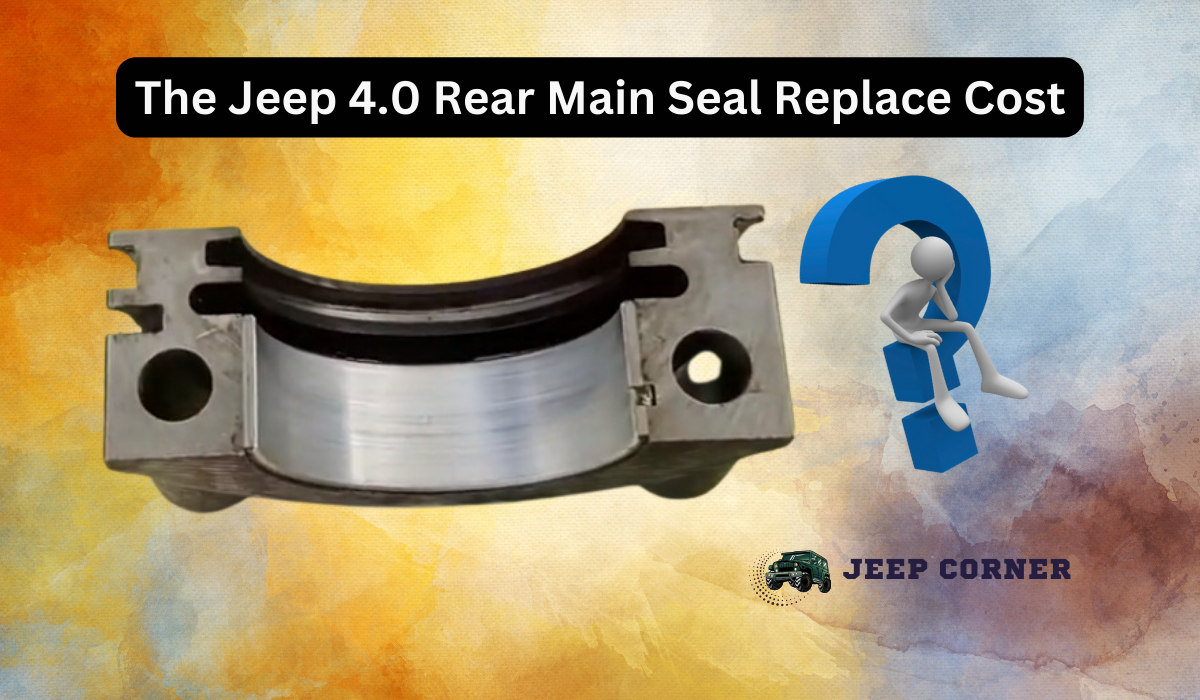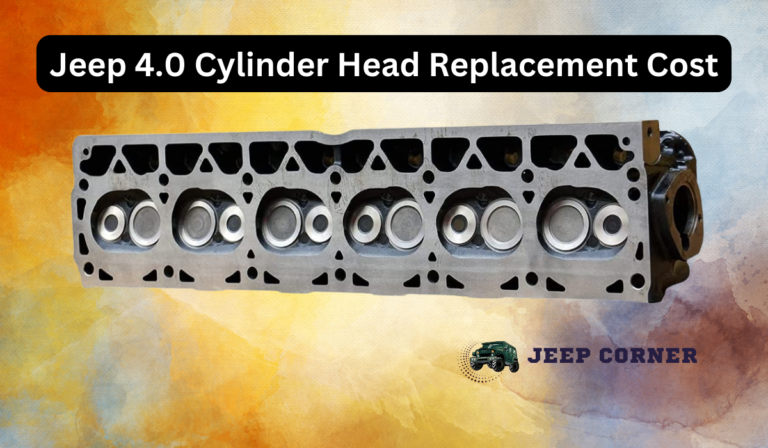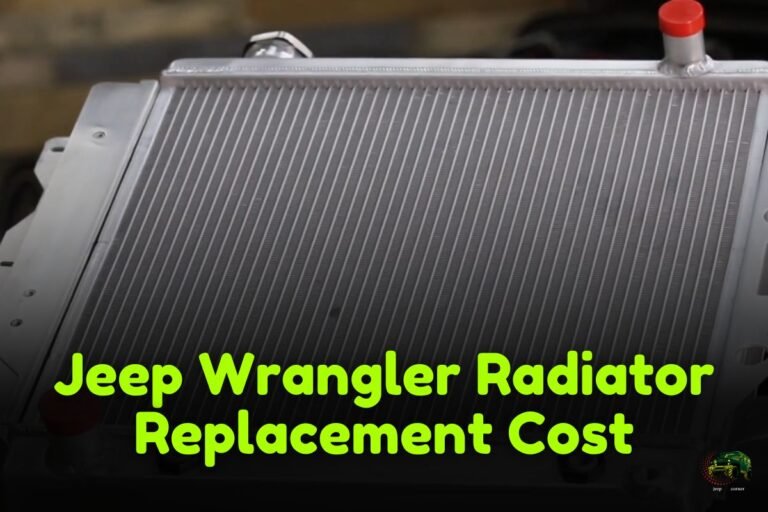The Jeep 4.0 Rear Main Seal Replace Cost: An In-Depth Guide
The rear main seal helps to create a seal for oil and other fluids in the engine, ensuring that the engine runs smoothly and efficiently. And sometimes this gets damaged and leaks, so you need to replace it.
But what is the Jeep 4.0 rear main seal replace cost? It can cost between $500 and $1500, depending on the location and labor involved. A rear main seal replacement typically includes the cost of parts, labor, and a diagnostic fee.
Continue reading to find out how much it costs to replace the Jeep 4.0 rear main seal. From the parts required to the labor cost, we’ll explain everything you need to know about this essential repair.
Table of Contents
An In-Depth Guide About The Jeep 4.0 Rear Main Seal Replace Cost
The rear main seal is a gasket between the crankshaft and the transmission bell housing. When the rear main seal begins to wear out or become damaged, it can cause leaks and other issues with your engine.
In that sense, this seal is necessary for any Jeep 4.0 engine and must be replaced and maintained regularly. This is why it’s essential to be aware of the signs of a failing rear main seal so that you can address the problem before it becomes more severe.
So how much does your rear main seal replacement cost you think? Depending on your Jeep’s make and model, the repair cost can range from $500 to $1,500.
The replacement cost will also depend on the labor costs of the mechanic you choose to work on your vehicle and the cost of any necessary parts.
Labor costs typically range between $410 and $1100. The actual rear paramount seal price is relatively low compared to the labor cost. It goes from $15 to $45.
Additionally, it’s essential to remember that the repair cost could be even higher if the rear main seal has caused damage to any other engine components.
Additional parts include gaskets, seals, and O-rings. The price of these parts can range from $10 to $50, depending on the make and model of the vehicle. That brings the overall cost to an average range of $500-$1400. Remember that this cost estimate does not include local taxes, charges, or fees.
When Should You Replace A Rear Main Seal In Jeep 4.0?
As mentioned above, a rear main seal is responsible for keeping oil from leaking out of the back of the engine. In a Jeep 4.0 engine, the rear main seal should be replaced when it begins to wear out or when it starts to leak oil.
The rear main seal is a rubber seal located at the back of the engine, between the crankshaft and the engine block. It helps keep the crankcase pressure from leaking and the oil from leaking out of the engine.
When the seal starts to wear out, it will cause an oil leak, which can be very damaging to your engine. So when the rear main seal starts to wear out? Read on the following signs. It is vital to get the rear main seal replaced as soon as possible if you notice any of the signs below.
- An oil leak coming from the back of the engine; you should also check the oil level regularly, as an oil leak can cause the oil level to drop.
If the oil level is low, the rear main seal is likely leaking. You should also check around the engine’s base for any signs of oil seepage.
- A sudden decrease in oil pressure; if the pressure drops below the recommended level, it could indicate a problem with the seal. You should also check the dipstick for any oil contamination or sludge signs.
- You may also notice a decrease in the vehicle’s performance if the rear main seal fails. This could be due to a lack of engine oil and lead to a reduction in power and fuel efficiency.
- Increased engine noise; as the seal starts to fail, the crankcase pressure can escape and cause increased engine noise.
- The smell of heavy burning oil inside your vehicle could also signify a problem with the rear seal.
- Visible smoke coming from under your vehicle. When oil leaks due to a defective rear seal, the oil frequently spills on the vehicle’s exhaust and produces smoke.
As the longer this problem is left, the more damage it can cause to the engine. Besides, it is recommended that the rear main seal be replaced every 30,000 miles.
What Is the Process for Replacing the Rear Main Seal?
The most crucial step is ensuring the engine is completely cooled down before beginning the repair. Once the engine has been cooled,
- The oil pan must be removed to access the crankshaft flange.
- Thus, the crankshaft flange needs to be removed to access the rear main seal. Once the flange has been removed, the rear main seal can be accessed and replaced.
- When replacing the rear main seal, it is crucial to use the correct seal for the Jeep 4.0 engine.
- Once the proper seal is installed, the crankshaft flange must be reinstalled and tightened to the correct torque specifications. Likewise, once the flange is reinstalled, the oil pan can be replaced and refilled.
- Finally, the engine must be started and inspected for leaks or other issues.
Here is a step-by-step guide on replacing a rear main seal.
Step 1: Gather the necessary tools and supplies. You will need a new rear main seal, a sealant, a new oil pan gasket, and a socket set. You may also need a floor jack, stands, and a few other tools depending on the Jeep 4.0 model you are working on.
Step 2: Disconnect the negative battery cable and remove the starter. This will give you enough room to access the rear main seal.
Step 3: Using a socket, remove the bolts that hold the oil pan in place. Carefully lift the oil pan away without straining or damaging the gasket.
Step 4: Once the oil pan is removed, you can see the rear main seal. Using a flathead screwdriver, carefully pry the seal away from the engine block.
Step 5: Clean the area around the seal with a rag and a degreaser. This will help ensure a good bond between the new seal and the engine block.
Step 6: Apply a thin sealant layer to the area, then carefully place the new seal. Make sure it is properly seated, and all edges are sealed.
Step 7: Replace the oil pan and the gasket, tightening the bolts to secure the pan.
Step 8: Reinstall the starter.
Step 9: Reconnect the negative battery cable and start the engine. Check for any leaks or signs of damage.
Replacing the rear main seal of a Jeep 4.0 requires attention to detail and the proper tools. A qualified mechanic or experienced do-it-yourselfer should only attempt it. Doing it incorrectly can result in damage to the engine or other components.
How Long Does It Take To Replace a Rear Main Seal?
Replacing the rear main seal on a Jeep 4.0 engine is a labor-intensive job that can take several hours. The time required will vary depending on the mechanic’s ability and expertise and the condition of the parts.
Remember that the duration includes the time it takes to remove and replace the old seal and diagnosing time. The job can take anywhere from 4 to 8 hours.
FAQs
Here are other frequently asked questions.
Q: Why is a Rear Main Seal replacement necessary?
A rear main seal replacement is necessary when the seal is worn or damaged. Common signs that the rear main seal may need to be replaced include oil leakage, visible damage to the seal, and decreased engine performance.
If not replaced, a worn rear main seal can cause significant problems, such as engine failure.
Q: What are the benefits of replacing a rear main seal?
Replacing a rear main seal can reduce oil consumption, improve fuel efficiency, and increase engine performance. It can also help to reduce the risk of engine damage due to oil leaks.
Conclusion
A rear main seal replacement is an essential repair for Jeep owners to be aware of as it can be pretty costly. Knowing the signs of a failing rear main seal as well as the estimated cost of the repair, can help Jeep owners to prepare and budget accordingly.
Additionally, there are a few ways to save money on replacement. They include shopping around for the best price and looking for coupons or discounts from mechanics in your area.
You may also like
-
All You Need To Know About Jeep 3.8 Engine Replacement Cost
-
10 Common Jeep Engine Problems with Solution
-
How To Reset Check Engine Light On Jeep Wrangler: 6 ways
-
How to Reset Tire Pressure Light on Jeep Cherokee: Quick & Easy Guide
-
How to Manually Close Jeep Renegade Sunroof: Easy Step-by-Step Guide
-
How to Turn on Night Vision Jeep Grand Cherokee: Quick Guide








